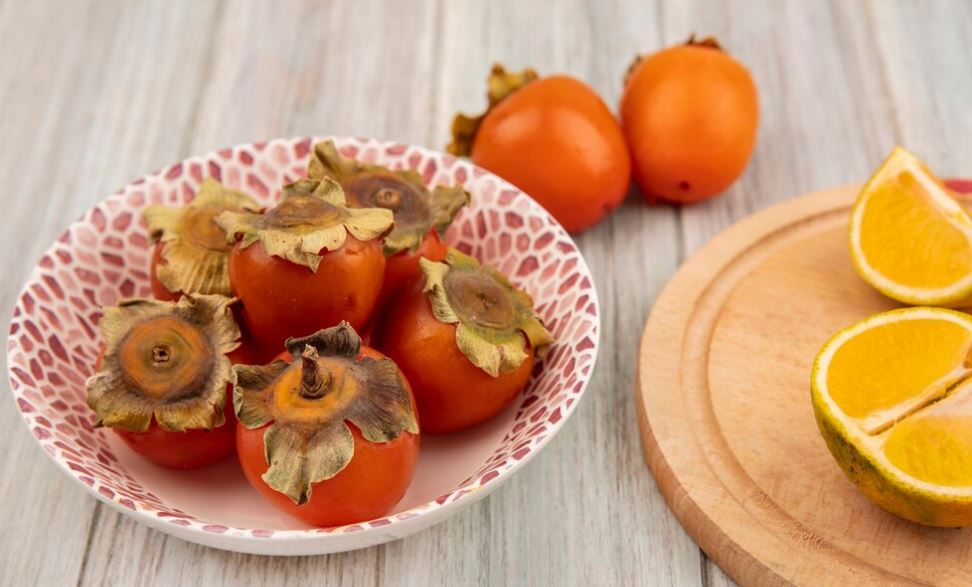Frequently disregarded in favor of more popular fruits are persimmons, the colorful, honey-sweet fruits that arrive with the crispness of autumn. However, as more foodies become interested in these nutrient-dense treats, the question of whether or not persimmon skin is edible keeps coming up. Many people are beginning to wonder if the skin of this delicious fruit is edible or if it’s better to peel it off due to the increased interest in food sustainability and optimizing nutritional benefits.
The Unexpected Reality: Persimmon Skin Can Be Eaten
The good news is that the skin of persimmons is full of nutrients and can be eaten. The skin is safe to eat whether you’re biting into a Hachiya persimmon, which gets soft and jelly-like when ripe, or a Fuyu persimmon, which is known for its firm texture and sweetness. It is actually more than just a protective outer layer because it provides some unexpectedly nourishing advantages.
Quick Facts on Persimmon Skin:
| Topic | Details |
|---|---|
| Edibility | Yes, persimmon skin is safe to eat and provides nutritional benefits like fiber and antioxidants. |
| Types of Persimmons | Fuyu (non-astringent): Ideal for eating with skin. Hachiya (astringent): Peel if unripe. |
| Health Benefits | High in fiber, vitamin A, and vitamin C; supports digestion and overall immune health. |
| Ripeness | Eat Fuyu when firm, Hachiya should be very soft before eating the skin. |
| How to Eat | Eat Fuyu like an apple (with skin), or spoon out the soft flesh of Hachiya and optionally enjoy the skin. |
| Eco-Friendliness | Eating the skin reduces food waste and is a more sustainable option. |
An Abundance of Nutrients
The high fiber, vitamin A, and vitamin C content of persimmon skins makes them an excellent addition to a well-balanced diet. Skin fiber helps maintain a healthy digestive system and prolongs feelings of fullness. While vitamin C boosts the immune system and encourages the production of collagen for healthy skin, vitamin A promotes healthy vision. For people who want to increase their daily intake of vital vitamins and minerals, eating the fruit whole—skin included—can be especially advantageous because the skin contains concentrated amounts of these nutrients.
Handling Persimmons’ Astringency
That being said, it’s not always easy to decide whether or not to eat the skin of persimmons. The astringent taste that leaves your mouth feeling dry and puckered is likely familiar to anyone who has ever tasted an unripe persimmon. Tannins, which are more concentrated close to the skin, are the cause of this bitterness, particularly in unripe Hachiya persimmons.
However, the tannins in these fruits dissolve as they ripen, making the fruit sweeter and the skin much more appetizing. Fuyu persimmons are the perfect option for people who would rather not peel because their skin is always sweet and pleasant due to their non-astringent nature.
How Persimmon Skin Is Enjoyed
Here’s how to get the most out of persimmon skin if you’re interested in eating it:
- Selecting the Correct Persimmon: Opt for a Fuyu persimmon for a tasty, hassle-free experience. These fruits are ideal for eating with their skins on because they are ripe even when they are firm. Just cut them into slices and savor the naturally sweet, soft fruit and its nutrient-rich skin.
- Await Ripeness: Patience is essential when growing Hachiya persimmons. Let the fruit ripen completely until it’s mushy and soft. It will be a delight to eat with or without the skin at this point because the flesh will be delightfully smooth and the skin will be much sweeter.
- Include in Recipes: There are a variety of ways to enjoy the skin if you’re not ready to eat it by itself. The fruit, skin included, can be added to salads, smoothies, or desserts. Without overpowering the flavor of the sweet flesh, the skin will provide a burst of color and an additional nutritional boost.
- Remember the Benefits: Eating the skin of a persimmon is a way to get more out of your fruit, not just for convenience. It is an environmentally friendly, health-conscious option because the additional fiber and antioxidants can help your skin, digestive system, and general health.
Is Persimmon Skin Always Appropriate to Eat?
Even though the skin is edible and nutritious, not everyone likes the way it tastes or how slightly bitter it is, especially if the fruit isn’t completely ripe. Peel off the skin if you want a smoother, sweeter experience, especially with Hachiya persimmons. The decision to eat or not eat persimmon skin ultimately comes down to personal preference. Eating the skin is a great option, though, if you want to increase your intake of fiber or utilize all the nutrients the fruit contains.
In summary, embrace your skin.
To sum up, persimmon skin is a nutrient-dense addition to your diet in addition to being edible. The type and ripeness of the persimmon greatly influence whether you decide to eat it or peel it off. But by adding the fruit’s skin to your food, you’re optimizing its nutritional value in addition to improving its flavor and texture. Don’t be afraid to eat the entire Fuyu persimmon, skin and all, the next time you come across one.

